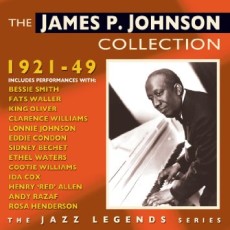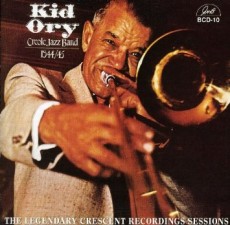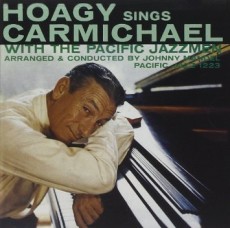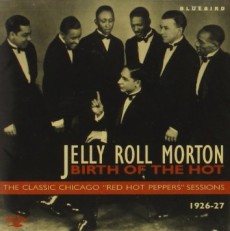
Daily Dose Of Jazz…
James P. Johnson was born James Price Johnson on February 1, 1894 in New Brunswick, New Jersey and was also known as Jimmy Johnson. A move to San Juan Hill, where Lincoln Center stands today, and subsequent move uptown by 1911, exposed him to the musical experience of New York City’s bars, cabarets and symphonies and listening to Scott Joplin attributed to his early influences. With perfect pitch and excellent recall he was soon able to pick out on the piano tunes that he had heard.
Johnson got his first job as a pianist in 1912, left school to pursue his career in music. From 1913 to 1916 Johnson spent time studying the European piano tradition with Bruto Giannini, spending the next four to five years studying other pianists and composing his own rags. In 1914, he met Willie “The Lion” Smith and became best friends. By 1920 he had gained a reputation as a pianist on the East coast on a par with Eubie Blake and Lucky Roberts, making dozens of piano roll recordings and recording for the Perfection, Artempo, Rythmodik, QRS and Aeolian labels.
James was a pioneer in the stride playing of the jazz piano. He developed into the favorite accompanist of Ethel Waters and Bessie Smith. He continued to compose and record during the 1920s and 1930s he recorded on W. C. Handy’s Black Swan label as well as Columbia. He branched out and became musical director for the revue Plantation Days, went to Europe with the show that toured for five years and made it to Broadway.
By the Depression Era his career slowed down somewhat and he found it difficult to adapt to the new swing era music gaining popularity. In the late 1930s Johnson slowly started to re-emerge with the revival of interest in traditional jazz, but suffering a stroke in 1940 took him out of the action until 1942 when he began to record, with his own and other groups with Eddie Condon, Yank Lawson, Sidney de Paris, Sidney Bechet, Rod Cless and Edmond Hall. He went on to record for jazz labels Asch, Black and White, Blue Note, Commodore, Circle and Decca, perform with Louis Armstrong and was a regular guest on the rudi Blesh This Is Jazz broadcasts.
He would teach Fats Waller his Carolina Shout composition, Duke Ellington learned it note for note from his piano roll and the tune became a right of passage for every contemporary pianist. Considered the last major rag pianist and the first major jazz pianist he became the bridge between the two styles. His influence led to the emergence of Art Tatum, Donald Lambert, Louis Mazetier, Pat Flowers, Cliff Jackson, Hank Duncan, Claude Hopkins, Count Basie, Ellington, Don Ewell, Jimmy Guarnieri, Dick Hyman, Dick Weststood, Ralph Sutton, Joe Turner, Neville Dickie, Mike Lipskin and Butch Thompson.
Pianist and composer James P. Johnson, who composed the Roaring Twenties theme song Charleston, along with If I Could be With You One Hour Tonight, and whose music has appeared in countless films, passed away on November 17, 1955 at age 61.
More Posts: piano

Daily Dose Of Jazz…
Irving Harold Mills was born Isadore Minsky on January 16, 1894 in Odessa, Ukraine and emigrated with his parents and brother to the lower east side of New York City. After his father died in 1905, he worked a number of odd jobs until relocating with his wife to Philadelphia. By 1918 he was working for publisher Leo Feist and his brother Jack was working for music publishing firm McCarthy & Fisher.
In 1919 the brothers founded Jack Mills Music, later renamed Mills Music in 1928. Together the brothers discovered a number of great songwriters, including Sammy Fain, Harry Barris, Gene Austin, Hoagy Carmichael, Jimmy McHugh and Dorothy Fields. He was responsible for greatly advancing and even starting a few of the careers of Cab Calloway, Duke Ellington, Ben Pollack, Jack Teagarden, Benny Goodman, Will Hudson, Raymond Scott and many others. He was instrumental in getting Duke Ellington hired by the Cotton Club.
Although he only sang a little, Irving put together his own studio-recording group, Irving Mills and His Hotsy Totsy Gang. The group was comprised of Tommy and Jimmy Dorsey, Joe Venuti, Eddie Lang, Arnold Brillhardt, Arthur Schutt and Manny Klein. Over the years Glenn Miller, Benny Goodman and Red Nichols would also be members.
Mills was one of the first to record black and white musicians together, using twelve white musicians and the Duke Ellington Orchestra on a recording of St. Louis Blues on one side and a medly of songs called Gems from Blackbird of 1928 with Mills singing with Ellington’s orchestra. One of his most significant innovations was the “band within a band” concept, recording small groups to record hot small group sides for the various dime store labels.
He also started an artist booking company, a publishing subsidiary, record labels that recorded Cab Calloway, Hudson-DeLange Orchestra, Raymond Scott, Adrian Rollini, Barney Bigard, Cootie Williams, Rex Stewart,, Johnny Hodges, Noble Sissle, Frankie Newton, Johnny Hodges, Chu Berry, The Three Peppers, Billy Kyle and other minor jazz and pop acts in New York.
He produced one picture, Stormy Weather for 20th Century Fox in 1943 with Calloway, Lena Horne, Zutty Singleton, the Nicholas Brothers, Bill “Bojangles” Robinson and Fats Waller. Though Hollywood wanted him to produce more film he chose to return to publishing and recording.
Music publisher Irving Mills, who put his name on the compositions of numerous Black musicians including Duke Ellington and Barney Bigard, and whose estate to this day reaps the financial benefit of all the musicians whose music he stole, passed away on April 21, 1985 in Palm Springs, California.

Daily Dose Of Jazz…
Kid Ory was born Edward Ory on December 25, 1886 in Woodland Plantation near La Place, Louisiana. He started playing music with home-made instruments in his childhood but by his teens was leading a well-regarded band in Southeast Louisiana. A banjo player during his youth, it is said that his ability to play the banjo helped him develop “tailgate”, a particular style of playing that has the trombone playing a rhythmic line underneath the trumpets and cornets.
He kept La Place as his base of operations due to family obligations until his twenty-first birthday, when he moved his band to New Orleans. While Kid was living on Jackson Avenue, he was discovered by Buddy Bolden, playing his first new trombone, instead of the old civil war model but his sister said he was too young to play with Bolden. With one of the best-known bands in New Orleans in the 1910s, he hired many of the great jazz musicians of the city, including cornetists Joe “King” Oliver, Mutt Carey, and Louis Armstrong.
In 1919 he moved to Los Angeles and he recorded Ory’s Creole Trombone and Society Blues there in 1921 with a band that included Mutt Carey, Dink Johnson and Ed Garland. They were the first jazz recordings made on the west coast by a Black jazz band from New Orleans. His band recorded with the recording company Nordskog and paying them for the pressings sold them under his own label of Kid Ory’s Sunshine Orchestra at a store in Los Angeles called Spikes Brothers Music Store.
Moving to Chicago in 1925 he was very active working and recording with Louis Armstrong, Jelly Roll Morton, King Oliver, Johnny Dodds, Bessie Smith, Ma Rainey and many others. He mentored Benny Goodman and later Charles Mingus. The Great Depression retired Kid from music, not playing again till 1943. From 1944 to about 1961 he led one of the top New Orleans style bands of the period working with Alvin Alcorn, Teddy Buckner, Darnell Howard, Jimmie Noone, Albert Nicholas, Barney Bigard, George Probert. Buster Wilson, Cedric Haywood and Don Ewell.
The Ory band was an important force in reviving interest in New Orleans jazz, making popular 1940s radio broadcasts, among them a number of slots on The Orson Welles Almanac program. In 1944–45 the group made a series of recordings on the Crescent Records label, founded by Neshui Ertegun for the express purpose of recording Ory’s band.
Retiring from music in 1966 he spent his last years in Hawaii with the assistance of Trummy Young. Trombonist and bandleader Kid Ory, one of the most influential trombonists of early jazz, passed in Honolulu on January 23, 1973.

Daily Dose Of Jazz…
Hoagy Carmichael was born Howard Hoagland Carmichael on November 22, 1899 in Bloomington, Indiana. He was named Hoagland after a circus troupe “The Hoaglands” who stayed at the Carmichael house during his mother’s pregnancy. His mother was a versatile pianist who played accompaniment at silent movies and for parties and by age six, he started to sing and play the piano, easily absorbing his mother’s keyboard skills.
Never having formal piano lessons by high school, the piano was the focus of his after-school life, and for inspiration he would listen to ragtime pianists Hank Wells and Hube Hanna. By eighteen he was living in Indianapolis, working in manual jobs in construction, a bicycle chain factory, and a slaughterhouse to help out the family’s income. During this period he befriended the Black bandleader and jazz pianist Reg DuValle, the elder statesman of Indiana and Rhythm King, who taught his jazz improvisation.
Carmichael went on to attend Indiana University and Indiana University School of Law graduating with a bachelor degree and law degree, respectively. He played with Bix Beiderbecke who introduced him to future collaborator, Louis Armstrong.
He began to compose song like Washboard Blues, Boneyard Shuffle and Riverboat Shuffle. In 1927 Hoagy composed and recorded Stardust, one of his most famous songs. His first major song with his own lyrics was Rockin’ Chair recorded by Armstrong and Mildred Bailey. He recorded it himself in 1930 with Beiderbecke, Bubber Miley, Benny Goodman, Tommy Dorsey, Bud Freeman, Eddie Lang, Joe Venuti and Gene Krupa.
He would go on to team up with Johnny Mercer and Frank Loesser, composing Georgia On My Mind, Up A Lazy River, In The Still Of The Night, Skylark, I Get Along Without You Very Well, The Nearness Of You and Baltimore Oriole among some many other jazz standards.
With his financial and social condition improved dramatically he began hobnobbing with George Gershwin, Fred Astaire, Duke Ellington and other music giants in the New York scene. He appeared in fourteen films, always performing one of his songs, appeared in numerous television roles, hosted musical variety radio and television programs, received Academy Awards for Best Original Song, was awarded an honorary doctorate in music by Indiana University, inducted into the Gennett Records Walk of Fame, recorded with Annie Ross and Georgie Fame, and penned two autobiographies.
Composer, pianist, singer, songwriter and actor, Hoagy Carmichael, passed away of heart failure in Rancho Mirage, California on December 27, 1981.

Daily Dose Of Jazz…
Jelly Roll Morton was born Ferdinand Joseph LaMothe on October 20, 1890 into a common-law creole of color family in the Faubourg Marigny neighborhood of downtown New Orleans, Louisiana. He started playing music as a child, showing early talent. After his parents separated, his mother married a man named Mouton and anglicizing it changed it to Morton.
At the age of fourteen, Morton began working as a piano player in a Storyville brothel, then known as a sporting house. In that atmosphere he often sang smutty lyrics and it was there he took the nickname “Jelly Roll”, which was African American slang for female genitalia. While working there, he was living with his religious, church-going great-grandmother; he had her convinced that he worked as a night watchman in a barrel factory. After Morton’s grandmother found out that he was playing jazz in a local brothel, she kicked him out of her house. However, Tony Jackson, also a pianist at brothels and an accomplished guitar player, was a major influence on his music.
Around 1904, Jelly Roll started touring in the American South, working with minstrel show, gambling and composing. He moved to Chicago in 1910 and New York City the following year where future stride greats James P. Johnson and Willie “The Lion” Smith caught his act, years before the blues were widely played in the North. His works Jelly Roll Blues, composed in 1915, has arguably become the first jazz song ever published. New Orleans Blues, Frog-I-More Rag, Animus Dance and King Porter Stomp followed as they were composed during this period. In 1917, he followed bandleader William Manuel Johnson Johnson’s sister Anita Gonzalez to California, where his tango The Crave, made a sensation in Hollywood. Returned to Chicago in 1923 to claim authorship of his recently published rag, “The Wolverines”, which had become a hit as “Wolverine Blues” in the Windy City. He released the first of his commercial recordings, first as piano rolls, then on record, both as a piano soloist and with various jazz bands.
In 1926, Morton succeeded in getting a contract to record for the largest and most prestigious company in the United States, Victor. This gave him a chance to bring a well-rehearsed band to play his arrangements. These recordings by Jelly Roll Morton & His Red Hot Peppers are regarded as classics of 1920s jazz. They featured Kid Ory, Omer Simeon, George Mitchell, Johnny St. Cyr, Barney Bigard, Johnny Dodds, Baby Dodds and Andrew Hilaire. And the group became one of the first acts to be booked on tour by MCA. Moving to New York City in 1928 he continued to compose and record for Victor with the aforementioned in addition to George Baquet, Albert Nicholas, Wilton Crawley, Russell Procope, Lorenzo Tio, Artie Shaw, Bubber Miley, Johnny Dunn, Henry “Red” Allen, Sidney Bechet,, Paul Barnes and Bud Freeman, Pops Foster, Paul Barbarin, Cozy Cole and Zutty Singleton.
During the Great Depression Morton lost his contract with Victor, struggled financially and took a job with a traveling burlesque show for steady income. In 1935, his 30-year-old composition King Porter Stomp arranged by Fletcher Henderson became Benny Goodman’s first hit and swing standard but Jelly Roll received no royalties from its recordings.
A move to Washington, DC saw him becoming the manager, piano player, master of ceremonies, bouncer and bartender of a bar located at 1211 U Street in the NW Black section of town called Shaw. Unable to make it a success due to the owner’s bad business decisions and being stabbed by a friend of the owner, Morton’s wife demanded they leave DC. Before his departure folklorist Alan Lomax invited him to record music and interviews at the Library of Congress, which ended after eight hours, though Lomax conducted longer interviews but only to notes without recording.
When Morton was stabbed and wounded, a nearby whites-only hospital refused to treat him, as the city had racially segregated facilities. Transported to a black hospital farther away it was several hours before being attended to and his recovery suffered, often he became short of breath. Worsening asthma sent him to a New York hospital for three months at one point and although he continued to suffer from respiratory problems when visiting Los Angeles, California with manuscripts of new tunes and arrangements, planning to form a new band and restart his career, pianist and composer Jelly Roll Morton passed away on July 10, 1941, after an eleven-day stay in Los Angeles County General Hospital. He was inducted into the Rock and Roll Hall of Fame, the Louisiana Hall of Fame and is a charter member of the Gennett Records Walk of Fame.
More Posts: piano


